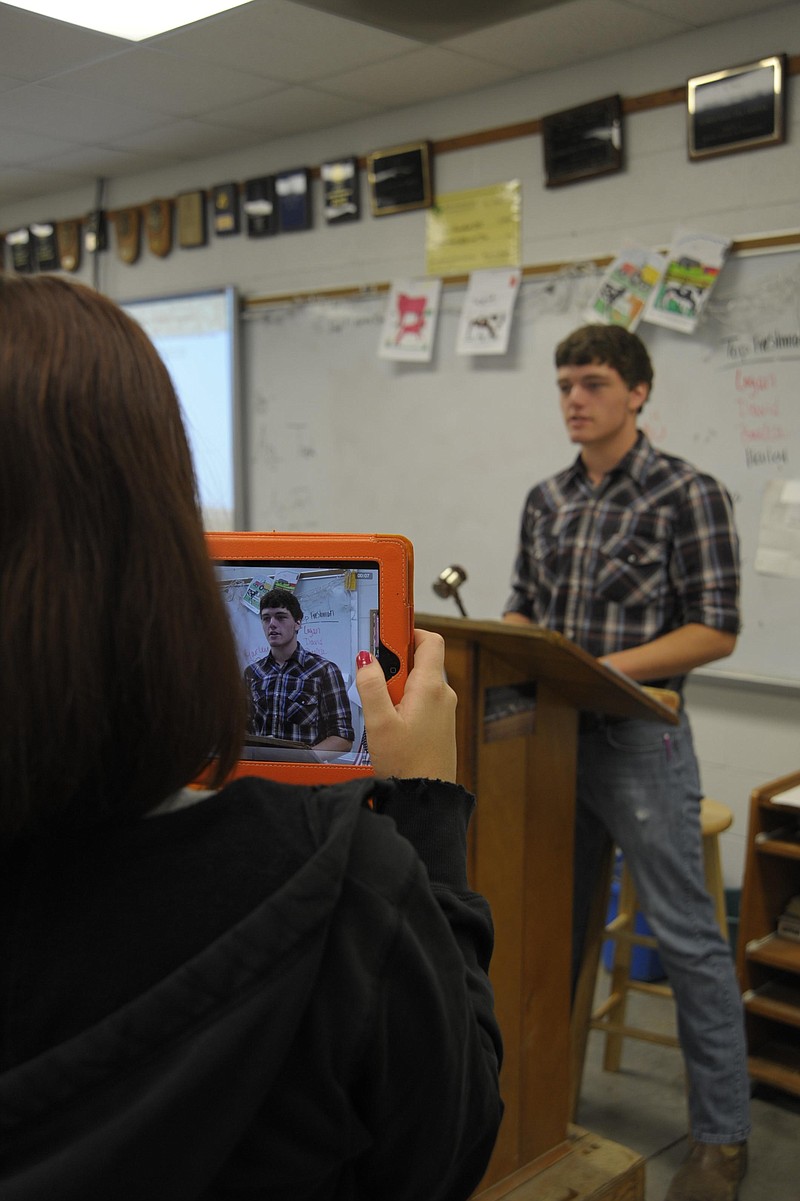By MICHELLE BROOKS
Democrat staff
RUSSELLVILLE - A 30-second book report was a great leap forward for teacher Kelly Beale in her use of technology in the classroom.
But for student Miranda Lueckenhoff, creating a cartoon figure of herself and typing in the report the Gami would say for her was a chance to have fun with a perennial assignment.
The Cole County R-1 School District reached into its reserve to purchase more than $30,000 in iPads - one for each teacher, as well as for some support staff, administration, secretaries and board members.
The Russellville school is not the first in its Show Me Conference of nine rural districts to take such a leap forward. But, combined with the Bring Your Own Device intiative opened last school year, it sets the school up for the goal to have a device in every student's hand within five years, said Superintendent Jerry Hobbs.
For veteran teachers like Beale who were instructing long before a computer was added to her classroom, discovering the possibilities and learning how to manipulate the latest gadgets is more of a challenge.
For younger teachers like middle school science teacher Matt Wessel, technology is a part of their daily routine.
That is the case for most of the students too. As the teachers carry around the foam-covered iPads and attempt to incorporate new applications into their lessons, students often find a chance to be the teacher in helping navigate the technology.
"Why should I be the teacher all of the time?" Wessel asked. "I can learn too."
Reading is a difficulty for Lueckenhoff, she said.
"But I survive when I pick a book I'm interested in; it's easy to stay with it," she said.
Likewise, Beale has confronted the unknown technology in the hopes of finding new and better ways to work with her students.
In the agriculture building, Alicia LePage inspired her business and leadership class to develop a recruitment video for the FFA Chapter.
Without the new iPad handy, making such a video would have required borrowing and returning equipment from the business department each class hour and then someone else would edit the video on special software.
The ag students have a sense of freedom and comfort because they have full control over each step of the development, LePage said.
"They're more vested in it; they can do what they want and make it their own," she said.
The video likely will be more of draw for potential chapter members, than a speech or PowerPoint presentation, she said.
Similarly, first-year teacher Taylor Chandler hopes to spark greater interest in his elementary music students now that he can connect the vast recordings available from Spotify with his classroom stereo system.
Before, he was trying to play detailed music selections from his computer and its less-than-adequate speakers.
"As soon as I heard we were getting iPads, I knew this would be great," Chandler said.
The portable technology also helps with classroom management, he said. Neither does he need a student to operate the PowerPoint presentation from his desk in the back of the room, nor does he need to stay at school for long hours to complete his work.
At a recent staff meeting, Chandler's coworkers were delighted to learn about the web-based DropBox storage that allows him to access files anywhere.
Christina Crews has been using her iPhone to run different Spanish language software in her classes.
Hands-on devices draw students into a higher form of learning, she said.
Wessel already was using his family's iPad for his lesson, particularly to collect useful Web sites on the Evernote application.
"Finding more science apps is just an extra piece to study to understand or understand more," Wessel said. "There's a lot of neat stuff out there."
But that is a teaching point, as well.
"We teach students to be stewards of the technology they use," Wessel said. "They need reasoning skills to know what information is valid and what to question."
In the middle school office, Secretary Susie Henson questioned at first what use she would have for the iPad.
But when technology coordinator Maribeth Russell set up a substitute calendar that could be accessed by both schools to eliminate duplication, Henson quickly was on board.
Then, as the transportation director's secretary, too, she found that the iPad helps her field departure and driver questions on evenings and weekends better than a paper calendar.
What was of even greater surprise was the savings on the reduction of paper usage, said Principal Karen Ponder. All staff correspondence and meeting documents are shared over the Internet.
Even the school board members no longer receive paper packets for their meetings.
"They're modeling for the rest of the district," Hobbs said. "Board members using the same technology as teachers and administrators sets a good example."
Going paperless districtwide could save up to 50 percent of paper costs in a year, he said.
"In a $6 million budget, $5,000 might not seem like much, but we pick up here and there and it adds up," Hobbs said.
As the 21st century learning model takes shape, teacher must adapt and incorporate new technologies.
"It's a whole new beginning for us," Hobbs said. "We understand; we can't teach kids the way we did in the industrial age.
"We have to think outside the box, how to better prepare our kids for the global market.
"Our instruction in the future will be limited only by our imagination."


